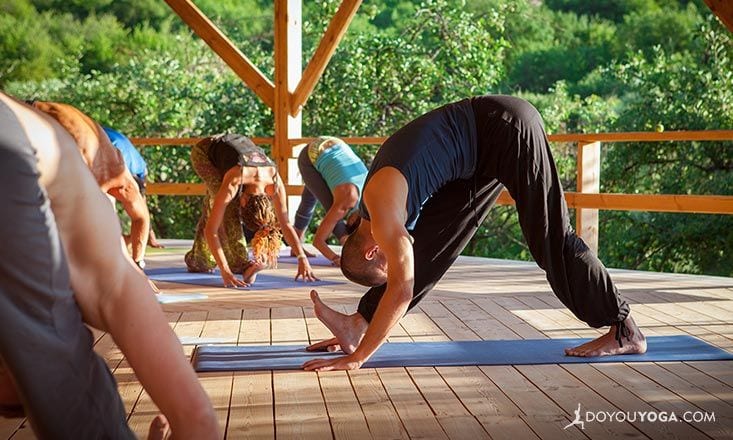For most new yoga teachers, there are two emotions surrounding teaching your first class: excitement and fear. No matter how prepared we feel from our yoga teacher training, how many times we practice a sequence in front of the mirror, or how much time spent practicing Sanskrit, stepping in front of a class of yoga students for the first time is downright terrifying.
Even with the best training, there are so many little things that can and will “go wrong”. The good news is that these things happen to all of us, new and veteran teachers alike.
Here is the list of things that have “gone wrong” or very awkwardly in my yoga classes and how to recover from them.
1. Unexpected City Noise
Every Saturday morning, I show up to teach a blissful restorative class in Downtown Seattle. I have a killer playlist, a juicy, relaxing sequence, and an inspirational theme to tie it all together. Then it happens—a jackhammer starts pummeling the sidewalk, a leaf blower revs its engine outside the window, people on the street fight, yell, sing, swear.
It seems like every week there is something happening outside the studio that is a direct juxtaposition to what is happening inside. The only thing I can do in this situation is use it as an opportunity to expand on my weekly theme.
Whether it is cultivating inner peace, being present, or finding gratitude, the chaos outside the studio is just a reminder of the challenges we will face in reaching these intentions.
2. Mixing Up Left and Right
I don’t think that I’ve made it through a single yoga class without making this mistake. The truth is, I have a hard time with left and right outside of teaching yoga, so this has always been a point of anxiety for me.
While I want to mirror students so they don’t have to think about which side they should, doing so totally stifles my teaching and flow of my class. So, I usually position myself perpendicular to my students. This way, they have a side view of me, and I can demonstrate poses on the same side as them without it looking backwards.
Another big tip for times when you’re moving around the class and forget what side you’re on: go to the back of the class. If you stand at the back of the room, you can position yourself to face the same way as the students and figure out which hand is which. This has been a lifesaver for me!
3. Your Playlist Gets Shuffled
I thought that after the first time this happened to me I had learned my lesson, but for some reason, it’s one thing I tend to overlook in the pre-class setup. I’ll have the perfect progression of songs ready to go, but forget that I have my music set to shuffle. Next thing I know, we’re going from ambient music to hip hop. Whoops!
If this happens to you, the last thing you want to do is draw more attention to your mistake. As quickly as you can, start to slowly fade out the music. Switch to the song you actually want to play, and fade that song in. The less abrupt you can make the switch, the better.
It isn’t the blunder itself that takes students out of their practice, but rather our reaction to it. As much as you can, keep your reactions to yourself, and try to gracefully right the wrong.
4. Students with Sensitivities
As teachers, we all know that we need to ask students before adjusting them and entering their physical space. But, as I learned the hard way, we also need to ask students about using anything in class that they might have an allergy or sensitivity to.
I used to love getting to the studio early and setting the mood with candles and incense. Then, on multiple occasions, I had students tell me that the intensity of the incense was making them quite uncomfortable. This is a really important reminder that the things that we find pleasant and calming can make other people feel really unpleasant.
Now, I always ask the class if they are ok with incense, essential oils, or anything else I am putting in the group space or their personal space.
5. You Run Out Of Props
This isn’t a huge problem with a Vinyasa-style class, but for Restorative or Yin yoga classes when props are everything, this can be a tricky one. I’ve had classes where I can’t give everyone as many props as I’d planned for. The first time it happened, I didn’t realize until halfway through the class that some students were without a bolster!
Now, I do two things: 1) I have a backup plan for poses that require a lot of props. I also start with suggesting just a couple of props per student until I know how many will be in class. Then, 2) I’ll start handing out extras if there is time before class, or make sure I at least bring all of the extra props I need into the studio and hand them out to students as I see a need.
The important lesson here is to always have a backup plan and to keep your eyes on your students to make sure they are supported by props and by your teaching.
Here’s what I know for sure about teaching yoga: there are things that WILL go wrong. You will have an off day, you’ll trip over your words, your music won’t play, you’ll feel like the class was a complete disaster, etc. But here’s what you also need to know—none of it matters if you show up authentically and share your voice, your knowledge and your spirit with your class.
If your students can connect with you on those levels, no awkwardness or mistake you make during class can keep them from coming back.


